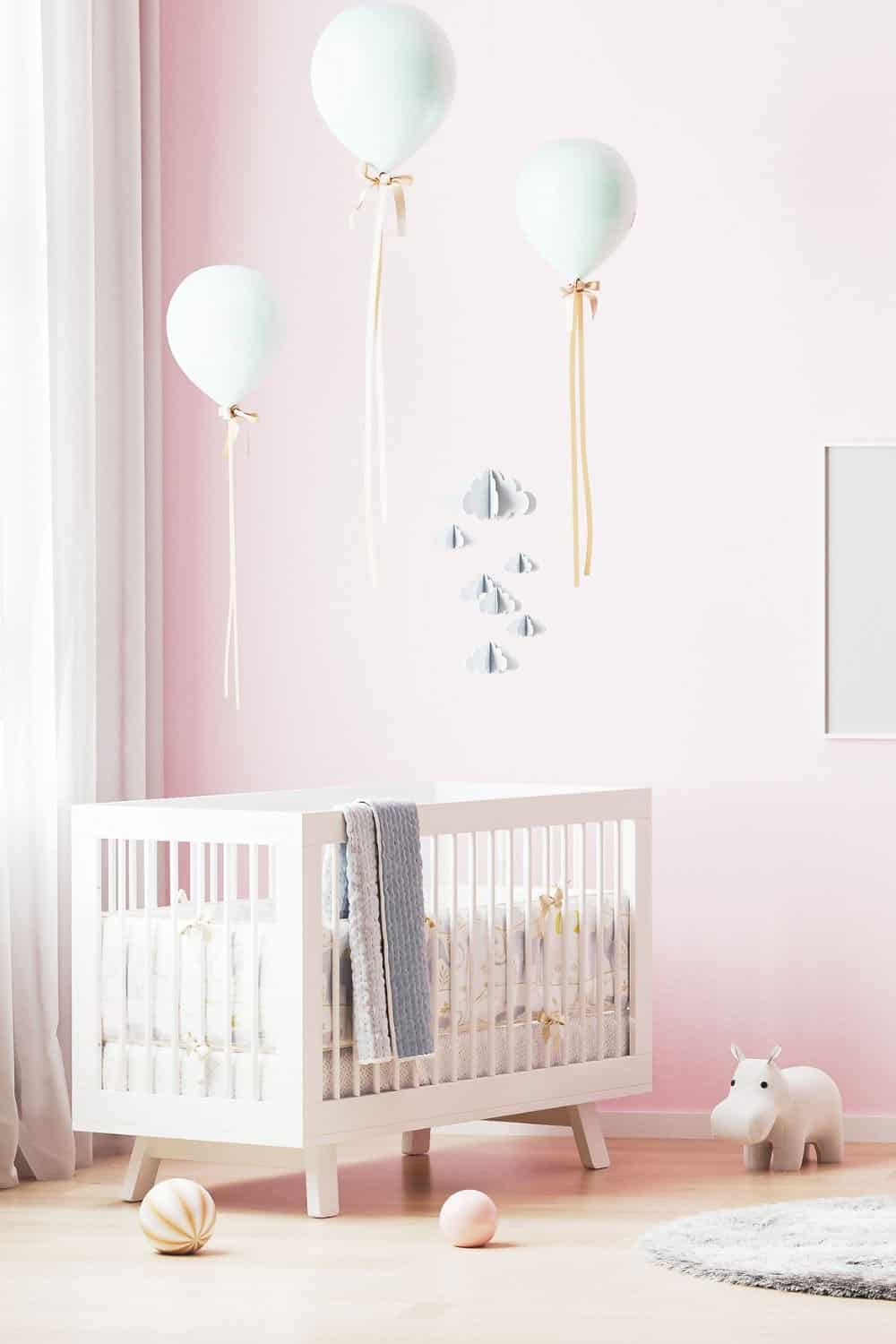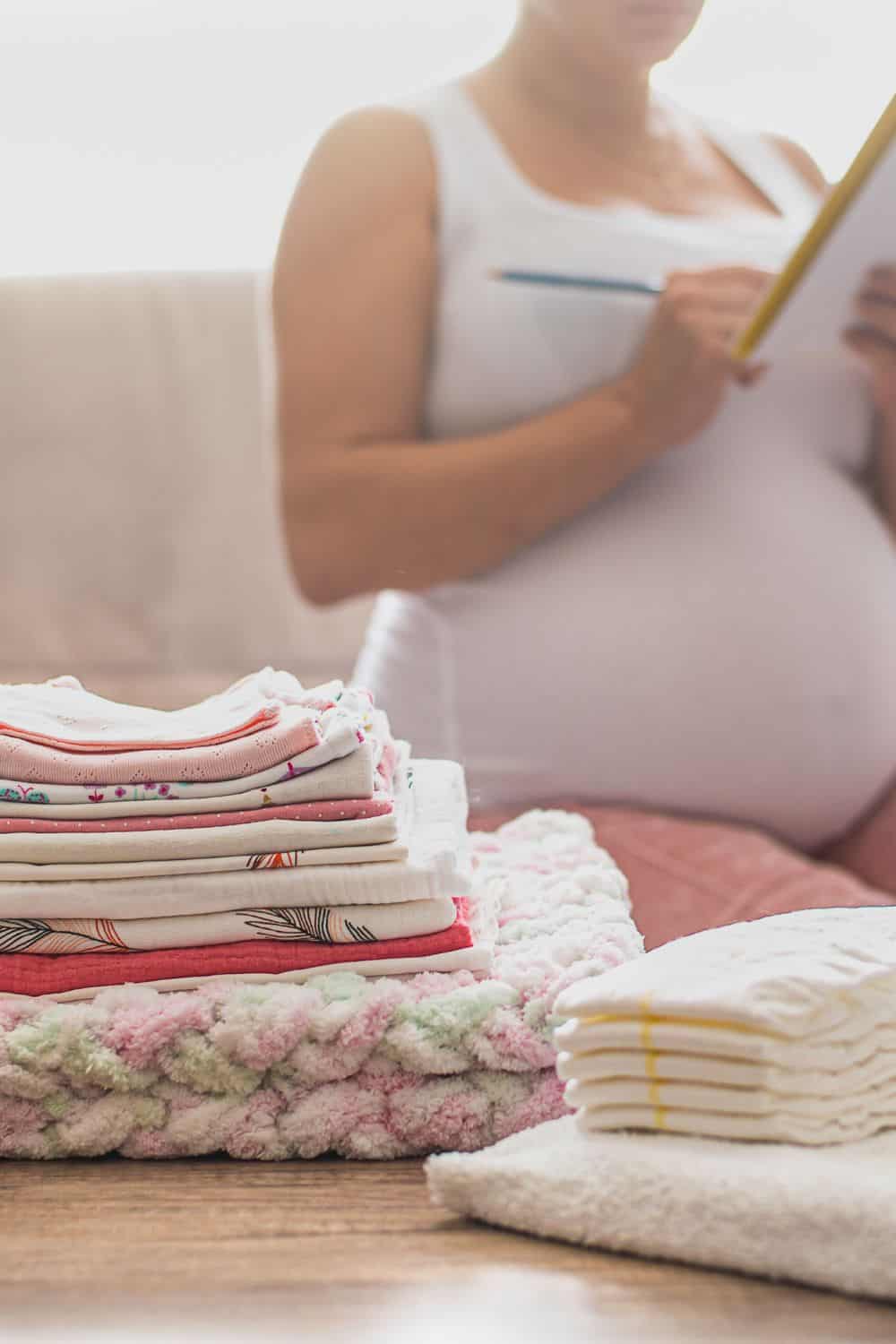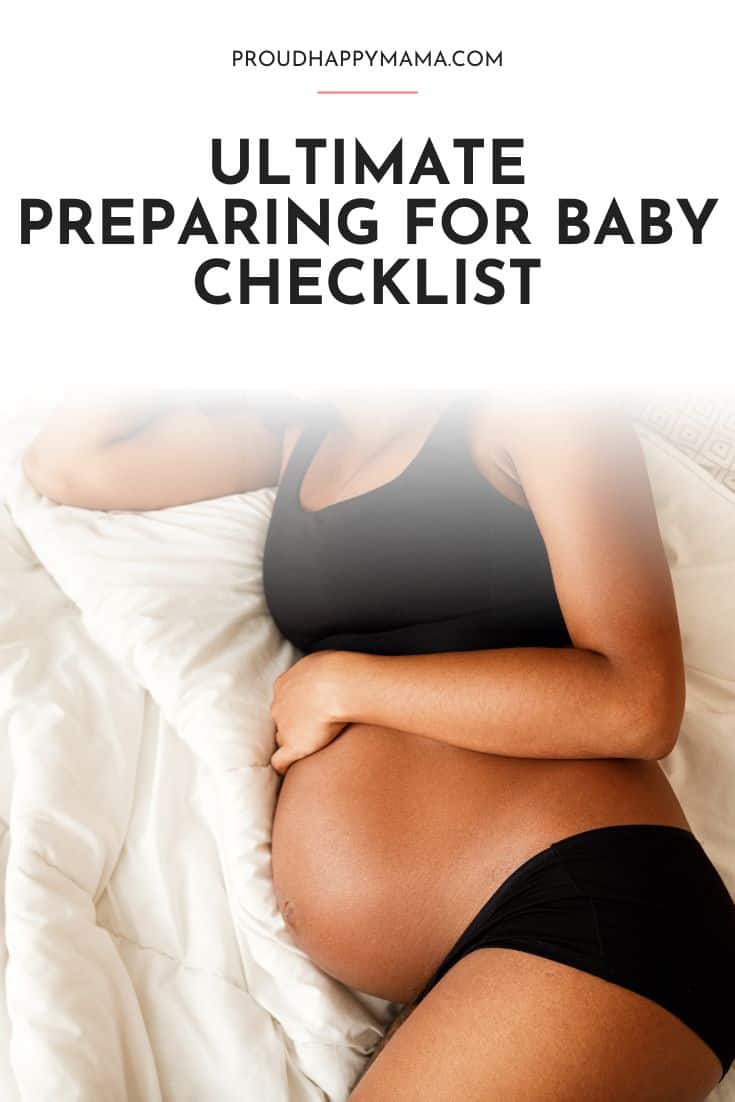Preparing For Baby Checklist
Are you wondering how to prepare for a baby?
Whether you’ve just found our you’re pregnant or your baby is due any day, we want to help ensure that you are ready for your baby’s arrival with our preparing for baby checklist.
When it comes to getting ready for a baby there are some key things that you need to do, from preparing your baby gear and setting up your nursery to packing your hospital bag.
But there are also some things that you may not have thought of that are going to help prepare you for a baby and ensure that you have everything you need to make your journey to motherhood that much easier.

How To Prepare For A Baby
Let’s dive in and take a look at what to do to prepare for baby by each trimester.
Trimester 1
Congratulations you’ve found out that you’re pregnant!
Welcome to the first trimester of pregnancy, mama!
But what now?
There’s already so much you can do to get this pregnancy started on the right foot. Getting organized and planning for baby’s arrival really does begin now. The first trimester of pregnancy is a great time to focus on health and nutrition, do some financial and life planning, and choose where to deliver.
So, to help you start preparing, below is a first trimester checklist with key steps to start taking during your first trimester to help you get ready for the baby.
When Does The First Trimester Of Pregnancy Start?
The first trimester of pregnancy is considered to start on the first day of your last menstrual period and ends with the last day of the 13th week from that point. In other words, your first week of pregnancy is actually when your last period was. You start counting weeks pregnant from there.
How Many Weeks Are In The First Trimester Of Pregnancy?
The first trimester of pregnancy lasts for 13 weeks. It is considered to be months 1-3 of pregnancy if you are counting ‘months pregnant’.

What To Do In The First Trimester Of Pregnancy?
1. Start Taking A Prenatal Vitamin
If you haven’t yest started to take a prenatal vitamin then now is the time to start. The early weeks of pregnancy are some of the most important in baby’s development. You want to make sure you are taking a vitamin with plenty of folic acid.
2. Choose An OBGYM, Midwife, Or Other Prenatal Care Provider
Some things you want to consider in choosing a provider and where to give birth:
- Obstetrician or Midwife?
- Hospital, birth center, or home birth?
- Will your provider be able to provide their services with your chosen birthing option?
- Would you like a doula?
- What are your postpartum care options?
3. Connect With Your Insurance Company
If you have not already looked at your health insurance cover, now is the time you should find out what your insurance coverage will be like regarding prenatal care, labor and delivery, postpartum hospital stay, and other postpartum care coverage.
By looking into all of this early on you’ll be able to switch to the plan that has the best coverage.
Some insurance companies will send you pregnancy ‘starter kits’ or other freebies if you let them know you’re pregnant as well.
4. Schedule And Prepare For Your First Prenatal Appointment
Schedule in your first prenatal appoint.
The first prenatal appointment is a meet and greet between you and your provider. You’ll go over things like family health history, discuss specific dos and don’ts for pregnancy, and even begin talking about care and birth preferences.
The most exciting part is that you’ll probably get to hear baby’s heartbeat or even get your first ultrasound images!
You can prepare for this appointment by brainstorming questions to ask your provider and listing any concerns you may have during pregnancy.
You may also want to ask about your prenatal and genetic testing options:
Nuchal Translucency Scan (NT Scan)
- Covered by the insurance and the ‘norm’ (for now)
- Measures baby’s neck during a 12-week ultrasound and combines that information with mom’s health and medical history to draw conclusions about possible chromosomal disorders
- Relatively high rate of false positives. This can lead to more (unnecessary) invasive testing and unwarranted anxiety
- Rate of false positives especially high for women under 30
Counsyl Prelude Prenatal Scan (Genetic Testing)
- Typically not covered by insurance
- Involves a blood draw and genetic testing in order to detect chromosomal disorders
- Very accurate results
- Allows to you find out baby’s gender at week 12 if you choose
- Very low rate of false positives
5. Learn About What Foods, Products, And Activities You Should Be Avoiding
There are some foods, products, and activities that are known to be risky to your unborn baby.
It is important to learn about these and ensure that you avoid them.
Now is the time to quit smoking, drinking alcohol and reduce your caffeine intake (limit to one 12-ounce cup of coffee per day).
You’ll also want to avoid raw fish, raw eggs, and deli meats. As well as beauty product ingredients such as retin-A, Retinol, formaldehyde, hydroquinone, benzoyl peroxide and salicylic acid, and more.
While the major things to avoid are pretty straightforward and are across the board, you will find that personal preferences of what to avoid vary from person to person during pregnancy.
Here are some great guides for pregnancy safe beauty products:
- Best Pregnancy Safe BB Cream
- Best Bath Products For Pregnancy
- Best Self Tanner for Pregnancy
- Pregnancy Safe Face Masks
- Pregnancy Safe Toners
- Best Pregnancy Safe Lash Serum
- Best Pregnancy Safe Eye Creams
- Best Collagen Supplements For Pregnancy
- Best Pregnancy Safe Facial Exfoliators
- Best Face Washes for Pregnancy
- Best Pregnancy Safe Shampoos
- Best Deodorant For Pregnancy
- Best Foundation for Pregnancy
- Best Body Washes for Pregnancy
- Best Body Lotion for Pregnancy
6. Eat Well, Exercise, and Stay Hydrated
Your body is hard at work creating another human, so you’re going to want to ensure that you are giving your body as much goodness as you can.
This includes fueling it with healthy and nutritious foods, trying to get 30 minutes of physical activity most days of the week, and increase your water up take to ensure that your hydrated.
You may also want to consider taking pre-natal exercises in your area or at least researching them for your second trimester.
7. Start Doing Kegel Exercises
Kegel exercises strengthen the pelvic floor muscles, which support the uterus, bladder, small intestine and rectum.
Regular Kegel exercise during pregnancy and after you’ve given birth can help improve and maintain your bladder and bowel control by increasing the strength, endurance, and correct function of these important muscles.
It is never too early to start Kegel exercises.
8. Check Your Finances And Start Working On A Budget
Whilst having a baby is full of adorable moment, cute little clothes, and cool baby items, it is also expensive. A baby is going to change your financial situation and it is something you should be budgeting for.
Planning financially for a new baby is one of the most important things you can do. Consider additional expenses that come with having a baby join the family.
9. Start Building Your Baby Registry
Whilst this may seem early, many new moms want start preparing their baby’s arrival by buying baby gear.
And who can blame them with all those adorable baby items! Afterall, buying baby gear and setting up your baby’s nursery is one of the most exciting parts of preparing for your baby.
But before you rush out and buy everything you need in the first week of finding out you’re pregnant, we recommend starting a baby registry.
A baby registry helps you to plan and budget for your baby essentials as well as include wish list items. You can also share this with friends and family and tick off items once they have been purchased. As no doubt you’ll have friends and family that will wanting to find ways to help you prepare for your baby, especially if you are looking to host a baby shower.
10. Invest In New Bras
Every pregnancy is different, but one of the main things many women experience in the first trimester is an increase in their boob size. You may even find that your boobs increase several bra sizes.
A well-fitting, supportive bra will be most helpful with keeping you comfortable. Skip maternity bras and instead invest in high quality, supportive nursing bras.
You may like our guide on how many nursing bras do I need?
11. Start A Pregnancy Journal
A pregnancy journal is a gorgeous way to keep track of your pregnancy.
With a pregnancy journal you can capture everything from the important pregnancy milestones to a weekly bump photo to recording all your thoughts and feelings throughout your pregnancy journey.
You may also option to use a baby memory book that has a pregnancy section that you can carry through for when your baby is born.
12. Think About How And When You’ll Announce Your Pregnancy
Announcing your pregnancy to family and friends is an exciting time and one to celebrate.
But when you and how choose to announce your pregnancy is a personal choice.
Some choose to wait to share their big news till the end of the first trimester when the rate of miscarriage drops, whilst others are happy to announce the news as soon as they find out.
Either way, you’ll want to decide who to tell and how. There are certainly many creative announcement ideas and fun expecting photo ideas out there.
Bes inspired by these pregnancy announcement ideas!
13. Connect With Other Moms, Especially Those Who Are Due Around The Same Time
Having a village around you is one of the best things you can do!
We recommend looking for prenatal care groups within your local area to find other mamas you can experience the journey of motherhood with.

Trimester 2
You’ve made it to trimester two, but now what should you do?
Below is our second trimester checklist with key steps to start taking during your 2nd trimester to help you with your baby preparation.
When Does The Second Trimester Of Pregnancy Start?
The second trimester of pregnancy starts with the first day of the 14th week and ends with the last day of the 27th week. It is considered to be months 4-6 of pregnancy if you are counting ‘months pregnant’.
What To Do In The Second Trimester Of Pregnancy?
1. Shop for Maternity Clothes
During your second semester you will start to notice that your pre-pregnancy clothes don’t fit the way they use to.
So, to make your pregnancy that more comfortable, start investing in some maternity clothes.
You don’t need to go overboard, especially as they are used for only a relatively short period, however, you will want to ensure that you have brought yourself the basics as well as a few pieces for special occasions such as your baby shower or maternity photoshoot.
You may even like our guide on the best places to have a baby shower!
2. Prepare Your Nursery
Setting up your nursery is a highlight for many new moms, especially if you have the nesting urge.
There is no right or wrong way to set up your nursery. It really is about making it a safe and functional space for your baby.
However, that doesn’t mean that you can’t decorate it in an adorable theme!
Here are a few of our practical guides when it comes to setting up your nursery.
- When should I start setting up the baby nursery?
- Best mini cribs
- Best cribs with changing station
- Best bassinet for small spaces
- Best baby monitors
- Best blackout curtains for nursery
- Best fans for nursery
- Best nightlight for baby
- Where to put a humidifier in a nursery
3. Decide If You Want To Find Out The Gender
Most doctors schedule an ultrasound at around 18 to 21 weeks, in which you can find out the gender of your baby if you choose to. Though sex may be determined by ultrasound as early as 14 weeks.
It is important to decide if you want to find out the gender or if you prefer to keep it a surprise until your baby is born. If you prefer not to find out, we encourage you to ensure that the doctor or person doing your ultrasound is made aware.
If you do choose to find out, then you may want to consider doing gender reveal to share the news with your family and friends.
4. Join A Pre-Natal Exercise Class
If you haven’t already, look to join a pre-natal exercise class. It’s a great way to help strengthen your body, keep you fit, and connect with other moms to be.
5. Start Applying Body Lotion
As your body starts to change with your growing baby, you’ll want to start applying a pregnancy safe body lotion to help reduce stretch marks.
Moisturizing can also help prevent your skin from dying out and becoming itchy, especially during winter months.
6. Start Choosing Baby Names
Without a doubt, choosing a baby name is one of the biggest decisions that new parents will make.
And rightfully so!
Your baby is destined to carry the name you choose for them throughout their entire life. And their name will have lasting impacts such as their social relationships or even employment opportunities.
So, it isn’t really something that you want to take lightly. No parent wants to end up with baby name remorse!
Here are a few things to consider:
Think About What Inspires You
With literally thousands of baby names to choose from you are going to need to start by narrowing down your options.
And the best place to start to do this is by thinking about the things that inspire you and your family.
You may look to your family culture and traditions, people of influence in your life, hobbies, or even your favorite characters from books or movies!
Write The Full Name Down & Say It Out Loud
Now you have a few names on your list, the next step is to start putting the full name together with any potential middle names and last names.
You’re going to want to see if you like the way it looks when it is written.
Then you want to say the name out loud.
You want to make sure you love how the whole name sounds together, including middle names if you are choosing any. As well as any shorten versions of the name.
Research The Full Name
You are looking to see if there any negative connotations that may deter you from loving the name.
It may seem like a bit of an overkill move, but you’re better off doing a quick google now than finding out down the track that there is an association with the name that you hate!
Finally, the last step in research your potential name is to check the domain availability. Now you may want to skip this step if technology is not an important factor for you. But for some parents, securing the domain name and possible social handles of your baby’s name is really important. Especially in this digital age.
And if you want a little help finding a baby name, we have thousands of baby names and baby names list to inspire you!
A few great places to start are:
7. Look into Birthing Classes
A birthing class is a great way for you and your partner to learn about the birthing process and newborn baby care.
It’s also a great way to connect with other expecting parents.
We recommend finding a birthing classes early on in your second trimester as they can fill up fast!
Or even consider joining up for an online pregnancy and birthing class!
8. Start Sleeping On Your Side
From 28 weeks of pregnancy, women should start to sleep on their side. This is to reduce the pressure on major blood vessel, that ultimately could reduce the blood flow to your womb ad restrict your baby’s oxygen supply.
A pregnancy pillow can be a great way to provide support to your growing belly and help provide more comfort.

Trimester 3
You’re on the home stretch of your pregnancy. Before you know it your precious little baby will be here!
So, now is the time to check off the last items on your to do list before your baby arrives with our third trimester checklist.
When Does The Third Trimester Of Pregnancy Start?
The third trimester of pregnancy starts with the first day of the 28th week and ends with the last day of the 40th week. It is considered to be months 7-9 of pregnancy if you are counting ‘months pregnant’.
1. Start Keeping Track Of Baby’s Kicks
Between weeks 16 and 25 of your pregnancy you’ll first start to feel your baby’s first movements if it’s your first pregnancy, even earlier for you second.
During your pregnancy it’s important to monitor your baby’s kicks and movements, especially as you near the end of your pregnancy. A change in your baby’s typical movement patterns could indicate that your baby is stressed. If you think that there has been a change then consult your doctor.
2. Pack Your Hospital Bag (And Dad’s!)
When to pack a hospital bag really is an individual choice, but we recommend that you have your hospital bag packed and ready by week 35 in case your baby decides to come early.
And ensure that you have Dad’s go bag packed and ready too!
3. Complete A Childbirth Class
If you haven’t already completed a birthing class then now is the time to do it. The same goes with finalizing your preferred hospital or birthing options.
4. Create A Birth Plan
A birthing plan is a great way to let those involved in your baby’s birth what your wishes are when it comes to having your baby.
Birth plans can be simple or complex. There is no one right format to suit every woman.
You’ll want to understand and include all of your pain coping options (both medical and not), birthing positions, immediate newborn care decisions, and special requests to maximize bonding and breastfeeding in the first hour.
It’s also recommended that you include your partner in creating this plan so they can best support and advocate for you.
5. Decide Whether You Plan To Breastfeed
Believe it or not, there is a lot you can do before baby arrives to make breastfeeding easier. Breastfeeding can be a challenge for a lot of mothers, but there are things you can do to help set you up for success if you choose to breastfeed.
We recommend learning how breastfeeding works, setting up a nursing station, connecting with a lactation consultation, and even joining a breastfeeding support group all prior to giving birth.
Our guide on breastfeeding tips for new moms is a great place to start researching!
And if you decide that breastfeeding is not an option for you, then now is the time to ensure that you have all your bottle-feeding essentials ready to go! From formula that tastes like breast milk to baby bottles for reflux to learning how to keep baby bottle warm at night.
6. Make Meals For Your Freezer
Your future self is going to thank you for organizing easy meals for when your baby arrives.
We recommend stocking your freezer full of easy meals that can be heated up or thrown into the slow cooker.
A great alternative if you don’t have the freezer space is organizing a food delivery service for the first few weeks.
7. Install The Car Seat
You’ll want to install your infant car seat well before you baby is due in case they arrive earlier than planned.
If it is your first time installing a car seat, then you may want to enlist the help of a certified car seat technician to help you.
8. Organize Photography
Between week 30 and week 36 you may want to consider doing a maternity photoshoot.
A maternity photoshoot is a fantastic way for you and your partner to reflect back on the life you’ve built together.
You can choose to have these photos done professionally or if this is out of your budget then look at having a friend takes some photos for you, either way you’ll be glad you did!
And while we are talking about photography, you may also want to consider if you would like a photographer to attend your birth and capture all the raw moments.
We also highly recommend having some newborn photography done. These should be taken within the first 7 to 10 days after birth while your little baby is still tiny and sleeping lots.
9. Plan For Visitors, Labor Updates, And Birth Announcements
When preparing for a baby, you will need to consider how you want to notify family and friends of the labor and/or birth or your baby.
Once people know you have gone into labor you may receive an influx of messages from people wanting updates and to congratulate you. Having a plan to manage these whether it be to turn off your phone, have a person of contact, or even sending a group message can help to alleviate any additional stress on you during the birth.
You will also want to have a similar plan for visitors.
Think about if you want visitors at the hospital or within the first week? And if yes, who would you like to visit? Then come up with a plan on how you want to organize these visits so you are not overwhelmed.
Some new parents like to do a sip and see so all the visits are done in one go others like to only have one or two visitors at a time and spread it out over a few weeks.
10. Prepare For Postpartum
It doesn’t matter how you gave birth, postpartum is tough!
You will be dealing with bleeding, swelling, bruising, and possibly tears and stiches, after all you’ve just given birth to a human being!
So, you may want to prepare for your postpartum recovery.
Final Thoughts On Getting Ready For Baby
While it is pretty easy to feel overwhelmed by all the things on your pregnancy to do list, just remember that it doesn’t have to be perfect. If you forget something, you can always have someone run to the shops and get it for you once the baby arrives.
This is your pregnancy journey. You can choose how you wish to prepare for the baby and what matters most to you.
And most importantly don’t forget to make some time to some fun things while pregnant!
We hope this guide has been helpful in helping you in preparing for you baby.
And if you love this guide on things to do before baby arrives, then you’ll love our guide on questions to ask your partner before having kids, best bath products for pregnancy, when to start buying diapers when pregnant?, and what is a diaper raffle?

